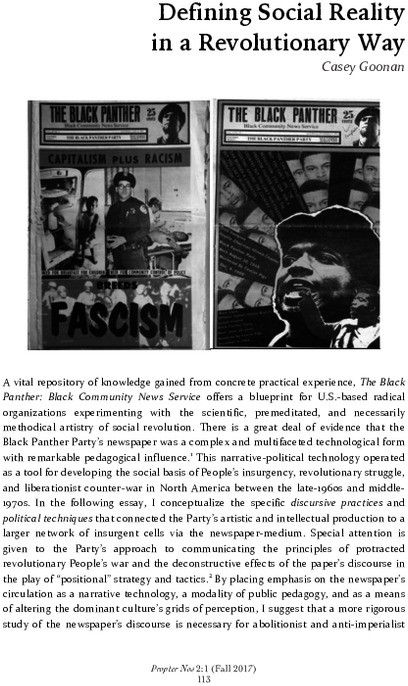Defining Social Reality in a Revolutionary Way
There is a great deal of evidence that the Black Panther Party’s newspaper was a complex and multifaceted technological form with remarkable pedagogical influence. This narrative-political technology operated as a tool for developing the social basis of People’s insurgency, revolutionary struggle, and liberationist counter-war in North America between the late-1960s and middle-1970s. In the following essay, I conceptualize the specific discursive practices and political techniques that connected the Party’s artistic and intellectual production to a larger network of insurgent cells via the newspaper-medium. Special attention is given to the Party’s approach to communicating the principles of protracted revolutionary People’s war and the deconstructive effects of the paper’s discourse in the play of “positional” strategy and tactics. By placing emphasis on the newspaper’s circulation as a narrative technology, a modality of public pedagogy, and as a means of altering the dominant culture’s grids of perception, I suggest that a more rigorous study of the newspaper’s discourse is necessary for abolitionist and anti-imperialist activists in the present. How did the newspaper articulate a shared experience of reality between disparately situated communities of struggle in this mid-twentieth century period of uprisings and revolt? How did the newspaper-medium aid in the coordination of disparately situated counter-hegemonic blocs, politico-military cells, and iconoclastic fighting formations? What was the political impact of The Black Panther in the Party’s art of operations?
The Black Panther: Black Community News Service was the weekly publication of the Black Panther Party. Founded in 1967 by Bobby Seale and Huey Newton, the Party was first named the “Black Panther Party for Self-Defense,” in line with its policy of armed self-defense and promotion of community self-determination for working class Black people. The paper was printed in San Francisco and distributed largely within the borders of the United States. Eventually, issues were also distributed internationally. Although Oakland is where the Party was headquartered, the newspaper was first printed as a tool to educate and organize the Black community in the city of Richmond, after the racist police homicide of Black teenager Denzel Dowell. For some time, it was printed irregularly until a weekly schedule for distribution was developed in 1969. Although the logistical dimensions of the publishing process are not our principal object of concern, a cursory review of its earliest list of editorial staff illuminates the peculiar immediacies and conditions of duress that contextualize the politics put forward in each issue of the newspaper.
...
Propter Nos 2:1 (Fall 2017)
Get Involved
If you'd like to help with maintaining or developing the website, contact us.
Publish
Publish your stories and upcoming events on Indybay.



